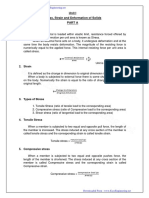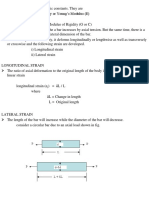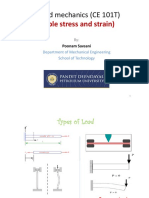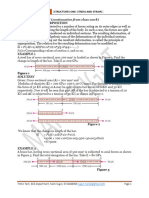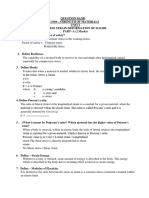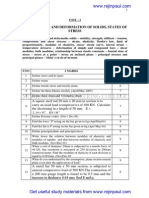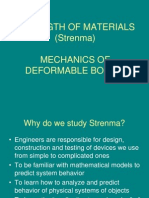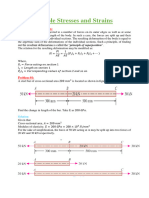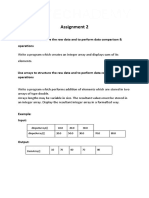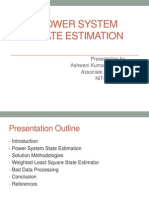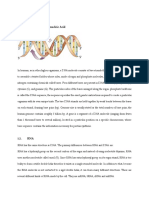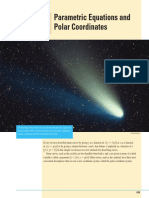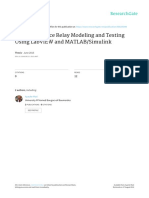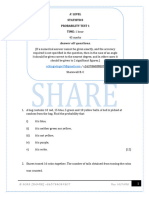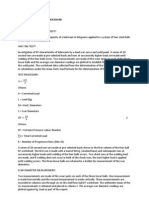Stress and Strain Calculations Guide
Uploaded by
HARNITH EVILLStress and Strain Calculations Guide
Uploaded by
HARNITH EVILLSimple Stresses and Strains Prof.
Vinay M L Gowda
Type 1 – Problems on Stress, Strain and Elongation
1 Kg = 9.81 N ~
̃ 10 N
1 Mega Newton = 1000,000 N = 1 MN = 106 N
1 Giga Newton = 1 GN = 109 N
1 Tera Newton = 1 TN = 1012 N
1 Pascal = 1 Pa = 1 N/mm2
1 x 106 N
1 Mega Pascal = 1 MPa = = 1 N/mm2
m2 x (1000)2 mm2
1 x 109 N
1 Giga Pascal = 1 GPa = = 1 x 103 N/mm2 = 1 kN/mm2
m2 x (1000)2 mm2
1012 N
1 Tera Pascal = 1 TPa = = 1 x 106 N/mm2
m2 x (1000)2 mm2
1. A rod 1000 mm long and 20 mm x 20 mm c/s is subjected to a pull of 10 KN. If
the modulus of elasticity of the material is 2 x 105 N/mm2, determine the stress,
strain and elongation of the rod.
Solution:
Data: L = 1000 mm, A = 20x20 = 400 mm2, P = 10 kN = 10x103 N, E = 2x105 N/mm2
P 10 x 103
Stress = σ = = = 25 N/mm2
A 400
PL 10 x 103 x 1000
Elongation = δL = = = 0.125 mm
AE 400 x 2 x 105
δL 0.125
Strain = ε = = = 1.25 x 10-4
L 1000
Working stress / Safe stress / Design stress:
The working stress is the stress induced due to the normal loads of its utilization for
designing the engineering structures. Structural components are designed for the
working stress in such a way that they may regain their original shape and size after
the removal of external loads.
Factor of safety:
For a brittle material, Eg: Cast Iron. It is the ratio of ultimate stress to working stress.
Ultimate Stress
Factor of Safety =
Working Stress
Prof. VINAY M L GOWDA, Department of Civil Engineering, B.M.S.C.E
Simple Stresses and Strains Prof. Vinay M L Gowda
For Ductile material, Eg: Mild Steel. It is the ratio of Yield stress to working stress.
Yield Stress
Factor of Safety =
Working Stress
The factor of safety must be always be such that the working stress is below the
elastic limit.
2. The ultimate stress for a hollow steel column carrying an axial load of 2 MN is 500
N/mm2. If the external dia. of the column is 200 mm, determine the internal dia.
Assume a factor of safety of 4.
Solution:
Data: P = 2 MN = 2 x 106 N, external dia. = 200 mm, Ultimate Stress = 500 N/mm2
F.O.S = 4
Ultimate Stress
Factor of Safety =
Working Stress
500
Working Stress = = 125 N/mm2
4
P
Stress = σ =
A
P 2 x 106
A= = = 16000 mm2
σ 125
2
π ( de 2 − di )
16000 =
4
16000 x 4
2002 - di2 = = 20371.83
π
di = √2002 − 20371.83 = 140.1 mm
3. A hollow steel tube 3.5 m long has external diameter of 120 mm. In order to
determine internal diameter, the tube was subjected to a tensile load of 400 kN
and extension was measured to be 2mm. if the modulus of elasticity for the tube
material is 200 GPa, determine the internal diameter of the tube.
Solution:
Data: L = 3.5 m = 3500 mm, de = 120 mm, P = 400 kN = 400x103 N, δL = 2 mm
E = 200 GPa = 200x109 N/m2 = 200x103 N/mm2
Prof. VINAY M L GOWDA, Department of Civil Engineering, B.M.S.C.E
Simple Stresses and Strains Prof. Vinay M L Gowda
2
π ( de 2 − di )
Area of tube =
4
PL
Elongation = δL =
AE
PL 400 x 103 x 3500
A= = = 3500 mm2
δL E 2 x 200 x 103
2
π ( de 2 − di )
= 3500
4
de2 – di2 = 4456.34
di = √1202 − 4456.34 = 99.72 mm
4. A bar of a rectangular section of 20 mm × 30 mm and a length of 500 mm is
subjected to an axial compressive load of 60 kN. If E = 102 kN/mm2 and µ = 0.34,
determine the changes in the length and the sides of the bar.
Solution:
Data: L = 500 mm, b = 20 mm, d = 30 mm, P = 60 kN = 60x103 N, µ = 0.34,
E = 102x103 N/mm2
Cross-Section Area = A = 20x30 = 600 mm2
P 60 x 103
Compressive Stress = σ = = = 100 N/mm2
A 600
σ 100
Linear or Longitudinal Strain = εLinear = = = 0.00098
E 102 x 103
εLateral
Poisson’s ratio = µ =
εLinear
εLateral = µ εLinear
Lateral Strain = εLateral = µ εLinear = 0.34 x 0.00098 = 0.00033
Decrease in length = δL = εLinear L = 0.00098 x 500 = 0.49mm
Increase in breadth = δb = εLateral b = 0.00033 x 20 = 0.0066 mm
Increase in depth = δd = εLateral d = 0.00033 x 30 = 0.0099 mm
5. A specimen of a material having original dia. equal to 13 mm and gauge length of
50 mm is tested under tension, the final dia. being 9 mm at fracture and gauge
length at fracture being 70 mm. During testing it is found that yielding occurs at a
Prof. VINAY M L GOWDA, Department of Civil Engineering, B.M.S.C.E
Simple Stresses and Strains Prof. Vinay M L Gowda
load of 35 KN (Lower yield point) and maximum load, that the specimen can take
is 60 KN (Ultimate load). The specimen fractures or breaks under a load of 30 KN.
Find
a) Yield stress
b) Ultimate tensile stress
c) the breaking stress
d) % Elongation
e) % Reduction in area
f) Safe stress adopting a F.O.S of 2
g) Young’s modulus if load corresponding to any point on the linear portion
of the stress–strain (or load extension) curve is 20 KN corresponding to
an extension of 0.0135 mm.
Solution:
π x 132 π x 92
Ao = = 132.73 mm2 Af = =63.617 mm2
4 4
35 x 103
Yield stress = = 264 N/mm2
132.73
60 x 103
Ultimate tensile stress = = 452 N/mm2
132.73
30 x 103
Breaking stress = = 226 N/mm2
132.73
Yield Stress 264
Safe stress = = = 132 N/mm2
F.O.S 2
Lf − Lo 70 − 50
% Elongation = x 100 = x 100 = 40%
Lo 50
A0 − Af 132.73 − 63.617
% Reduction in Area = x 100 = x 100 = 52%
𝐴o 132.73
PL
δL =
AE
PL 20 x 103 x 50
E= = = 558.08x103 N/mm2
A δL 132.73 x 0.0135
Percentage Elongation:
Change in Length
% Elongation = x 100
Original Length
Lf − Lo
% Elongation = x 100
Lo
Percentage Reduction in Area:
Prof. VINAY M L GOWDA, Department of Civil Engineering, B.M.S.C.E
Simple Stresses and Strains Prof. Vinay M L Gowda
Original Area−Area at Failure
% Reduction in Area = x 100
Original Area
A0 − Af
% Reduction in Area = x 100
𝐴o
Deformation of Bars connected in series
Type 2 – Problems on Deformation of Bars connected in series
Case 1: Bars made of same material with different Cross-Section
P d1 d2 d3 P
L1 L3
L2
P L1 L2 L3 Ln
dL = [ + + +⋯ ]
E A1 A2 A3 An
Case 2: Bars made of different material with different Cross-Section
P d1 d2 d3 P
L1 L3
L2
L1 L2 L3 Ln
dL = P [ + + +⋯ ]
A1 E1 A2 E2 A3 E3 An En
Case 3: Bars made with same Cross-Section and Load
P d d d P
L1 L2 L3
P L1 L2 L3 Ln
dL = [ + + +⋯ ]
A E1 E2 E3 En
Prof. VINAY M L GOWDA, Department of Civil Engineering, B.M.S.C.E
Simple Stresses and Strains Prof. Vinay M L Gowda
1. A bar has three sections of different diameters, 120 mm, 80 mm, and 100 mm,
and is subjected to a load of 500 kN as shown in Figure below. Find the total
elongation of the bar and the maximum stress in the material. E = 200,000 MPa.
Solution:
P1 L1 P2 L 2 P3 L3 P L1 L2 L3
dL = + + = [ + + ]
A1 E1 A2 E2 A3 E3 E A1 A2 A3
500 x 103 400 800 600
dL = [ 2 + 2 + ]
200000 (π/4) x 120 (π/4)x 80 (π/4) x 1002
dL = 2.5 [0.03536 + 0.1591 + 0.0764]
dL = 0.677 mm
The maximum stress will be in section BC, which has the least area and least diameter
P 500 x 103
σ= = = 99.47 N/mm2
A (π/4)x 802
2. A steel rod, 20 mm φ and 800 m long, is rigidly attached to an aluminium rod, 40
mm φ and 1 m long, as shown in Figure below. The combination is subjected to
a tensile load of 40 kN. Find the stress in the materials and the total elongation of
the bar. E for steel = 200 GPa, E for aluminium = 70 GPa.
Prof. VINAY M L GOWDA, Department of Civil Engineering, B.M.S.C.E
Simple Stresses and Strains Prof. Vinay M L Gowda
Solution:
σ in steel = 127.32 N/mm2, σ in aluminium = 31.83 N/mm2, dL = 0.964 mm
3. The bar shown in Figure is tested in a universal testing machine. It is observed
that at a load of 40 kN the total extension of the bar is 0.280 mm. Determine the
Young’s modulus of the material.
Solution: E= 200990 N/mm2
4. A bar of length 1000 mm and diameter 30 mm is centrally bored for 400 mm, the
bore diameter being 10 mm as shown in Figure below. Under a load of 30kN, if the
extension of the bar is 0.222 mm, what is the modulus of elasticity of the bar?
10
Solution: E= 200736 N/mm2
Prof. VINAY M L GOWDA, Department of Civil Engineering, B.M.S.C.E
Simple Stresses and Strains Prof. Vinay M L Gowda
Principle of Superposition:
When a number of loads are acting on a body, the resulting strain, according to
principle of superposition, will be “the algebraic sum of strains caused by individual
loads”.
Sometimes a body is subjected to a number of forces acting on its outer edges as well
as at body. In such cases, the forces are split up and their effects are considered at
each individual section. The resulting deformation of the body is equal to the algebraic
sum of the deformation of the individual section. Such a principle of finding out the
resultant deformation is called the principle of superposition.
In Equilibrium, P1 + P3 = P2 + P4
PAB LAB P L PCD LCD
dL = [± ± BC BC ± ± ........]
AE AE AE
Note: Use + ve sign if tension force is acting
Use – ve Sign if compressive force is acting
5. The forces that act upon a steel bar of c/s area 500mm2 is as shown in the figure
below. Determine the total elongation of the bar and stresses at each section. For
steel E = 200 G /m2.
Solution:
A = 500 mm2, E = 2x109 N/m2 =2x103 N/mm2
Check for equilibrium condition: ⃖50 + ⃖10 = 15 +45
⃖ = 60
60
Draw the free body diagram (F.B.D.) at each individual section
Prof. VINAY M L GOWDA, Department of Civil Engineering, B.M.S.C.E
Simple Stresses and Strains Prof. Vinay M L Gowda
The bars are with uniform cross section and material property
1
dL = [P1 L1 + P2 L2 + P3 L3 ]
AE
1
dL = [(50 x 500) + (35 x 1000) + (45 x 1500)] x 103 = 1.275 mm
500 x 2 x 103
σ1 = 100 N/mm2 (Tensile)
σ2 = 70 N/mm2 (Tensile)
σ3 = 90 N/mm2 (Tensile)
6. A steel bar ABCD of varying section is subjected to axial force as shown in figure
below. Determine the value of ‘P’ necessary for equilibrium. If E = 200 KN/mm 2.
Find the total elongation of the bar. And also, the stresses in each part.
Solution:
⃖ + 50
For equilibrium, 25 ⃖ = P +40
P = 75 – 40 = 35 kN
A1 = 200 mm2, A2 = 400 mm2, A3 = 300 mm2, E = 200 kN/mm2 = 200x103 N/mm2
Prof. VINAY M L GOWDA, Department of Civil Engineering, B.M.S.C.E
Simple Stresses and Strains Prof. Vinay M L Gowda
The material property is uniform at all the sections.
1 PAB LAB PBC LBC PCD LCD
dL = {+ − + }
E AAB ABC ACD
1 25 x 1000 10 x 1500 40 x 800
dL = x{ − + } x 103 = 0.97 mm
200x 103 200 400 300
25 x 1000
Stress in AB = σAB = = 125 N/mm2 (Tensile)
200
10 x 1000
Stress in BC = σBC = = 25 N/mm2 (Compressive)
400
40 x 1000
Stress in CD = σCD = = 133.33 N/mm2 (Tensile)
300
7. A member ABCD is subjected to a point loads P1, P2, P3 and P4 as shown in figure
below. Calculate the force P2 necessary for equilibrium if P1= 45 kN, P3 = 450 kN
and P4 = 130 kN. Determine the total elongation of the member, assuming the
modulus of elasticity to be 2.1 x 105 N/mm2.
Prof. VINAY M L GOWDA, Department of Civil Engineering, B.M.S.C.E
Simple Stresses and Strains Prof. Vinay M L Gowda
Type – 3 Problems on unyielding of Supports in bars
Consider the bar shown in figure of
constant c/s and is rigidly fixed between
the walls. An axial load ‘P’ is applied to the
A B bar at a distance ‘L1’ from the left end.
Consider the Free Body Diagram for the bar. The net resultant force is P and is
acting towards leftward i.e., ⃖F. To balance this resultant and for equilibrium the
reactions R1 and R2 at supports A and B are generated and considered to be acting
towards right side i.e., R1 and R 2 .
Σ H = 0; R1 + R2 = P - - (1)
R1 = P – R2 - - (2)
Since the bar at both ends, the deformation at all the section considered to be
zero. Hence, the compatibility condition, the total deformation in bar (dL) = 0.
Consider Part AB
= 𝐑𝟏
Consider Part BC
Since the bars are fixed at ends, total deformation is zero.
Total deformation = dL = dLAB + dLBC = 0
Segment AB is subjected to compression and BC is subjected to tension.
Therefore, Decrease in length AB = Increase in length BC
dLAB = dLBC
Prof. VINAY M L GOWDA, Department of Civil Engineering, B.M.S.C.E
Simple Stresses and Strains Prof. Vinay M L Gowda
PAB LAB PBC LBC
=
AE AE
R1 L1 R2 L2
=
AE AE
R2 L2
R1 =
L1
Substituting R1 in equation (1)
R2 L2
+ R2 = P
L1
R2 L2 + R2 L1 = P L1
P L1 𝐏 𝐋𝟏
R2 = =
L2 + L1 𝑳
Substituting R2 in equation (1)
P L1
R1 + =P
𝐿
P(L − L1 ) 𝐏 𝐋𝟐
R1 = =
𝐿 𝑳
8. A bar of 800 mm length is attached rigidly at A and B as shown in figure. Forces of
30 KN and 60 KN act as shown in the bar. If E = 200 x 10 3 MPa. Determine the
reactions at the two ends. If the bar diameter is 25 mm, find the stresses and
change in the length of each portion.
Solution:
The direction of reaction R1 and R2 may be assumed as shown in the figure.
⃖ = 𝑅1 +30 + 𝑅2
For equilibrium, 60
Prof. VINAY M L GOWDA, Department of Civil Engineering, B.M.S.C.E
Simple Stresses and Strains Prof. Vinay M L Gowda
ΣH = 0; R1 + R2 = 30 kN ----(1)
R1 = 30 – R2 ------ (2)
Consider Part AB
Consider Part BC
Consider Part CD
1
dL = [− PAB LAB − PBC LBC + PCD LCD ]
AE
π x 252
A= = 490.87 mm2
4
As supports are unyielding, total deformation = 0
dL = 0
1
0= {− [R1 x 275] − [(30 − R1 )x150] + [(30 − 𝑅1 )x 375] }
AE
- 275 R1 – 4500 – 150 R1 + 11250 – 375 R1 = 0
800 R1 = 6750
R1 = 8.44 kN
R2 = 30 – 8.44 = 21.56 kN
Stresses at each section
PAB 8.44 x 103
σAB = = = 17.20 N/mm2 [Compressive Stress]
A 490.87
PBC (8.44 + 30) x 103
σBC = = = 78.31 N/mm2 [Compressive Stress]
A 490.87
PCD 21.56 x 103
σCD = = = 43.92 N/mm2 [Tensile Stress]
A 490.87
Deformation at each section
R1 LAB 8.44 x 103 x 275
dLAB = = = 0.0236 mm
AE 490.87 x 200 x 103
Prof. VINAY M L GOWDA, Department of Civil Engineering, B.M.S.C.E
Simple Stresses and Strains Prof. Vinay M L Gowda
PBC LBC 38.44 x 103 x 150
dLBC = = = 0.0587 mm
AE 490.87 x 200 x 103
R2 LCD 21.56 x 103 x 375
dLCD = = = 0.0823 mm
AE 490.87 x 200 x 103
Check: dLAB + dLBC = dLCD
0.0236 + 0.0587 = 0.0823
0.0823 mm = 0.0823 mm
9. Two forces of 50 kN and 100 kN are applied to a bar fixed between two unyielding
supports. Compute the stresses and deformation induced in different materials.
Solution:
Let R1 and R2 be the reactions at the supports A and B as shown in the F.B.D
For Equilibrium,
ΣH = 0, - R1 + 100 – 50 – R2 = 0
R1 + R2 = 50 kN ------- (1)
R1 = 50 – R2 -------- (2)
Prof. VINAY M L GOWDA, Department of Civil Engineering, B.M.S.C.E
Simple Stresses and Strains Prof. Vinay M L Gowda
Consider Part AB
Consider Part BC
Consider Part CD
Applying the compatibility condition, the total deformation is zero
P1 L1 P2 L 2 P3 L3
dL = - - =0
A1 E1 A2 E2 A3 E3
R1 x 103 x 600 (100− R1 ) x 103 x 500 (50− R1 ) x 103 x 400
- - =0
1000 x 70 x 103 800 x 95 x 103 600 x 210 x 103
8.571 x 10-3 R1 – 0.659 + 6.579 x 10-3 – 0.159 + 3.175 x 10-3 R1 = 0
R1 = 44.70 kN; R2 = 50 – 44.70 = 5.3 kN
Stresses at each section
R1 44.7 x 103
σAB = = = 44.7 N/mm2 (Tensile Stress)
A1 1000
100−R1 (100 − 44.7) x 103
σBC = = = 69.125 N/mm2 (Compressive Stress)
A2 800
R2 5.3 x 103
σCD = = = 8.83 N/mm2 (Compressive Stress)
A3 600
Deformation at each section
R1 L1 44.7 x 103 x 600
dLAB = = = 0.383 mm
A1 E1 1000 x 70 x 103
(100 − R1 ) L2 (100 − 44.7) x 103 x 500
dLBC = = = 0.364 mm
A2 E2 800 x 95 x 103
R2 L3 5.3 x 103 x 400
dLCD = = = 0.0168 mm
A3 E3 600 x 210 x 103
Prof. VINAY M L GOWDA, Department of Civil Engineering, B.M.S.C.E
Simple Stresses and Strains Prof. Vinay M L Gowda
10. A compound bar made of aluminium and steel bars
connected in series is fixed rigidly at its two ends in vertical
position. The length of aluminium portion is 150 mm and
that of steel is 300 mm. Determine the stresses and
deformation induced in the two portions, if the compound
bar is subjected to a vertical load of 100 KN at its junction.
Take EAL = 70 GPa, AAL = 1000 mm2
ES = 200 GPa, AS = 1200 mm2
11. Two bars of steel and copper are rigidly connected
together b/w the two rigid supports as shown in figure. What
axial load ‘P’ is to be applied at the junction b/w steel and
copper such that stress in the steel and copper do not exceed
140 N/mm2 and 100N /mm2 resp. ES = 2 x 105 N/mm2, EC =
1 x 105 N/mm2.
Prof. VINAY M L GOWDA, Department of Civil Engineering, B.M.S.C.E
Simple Stresses and Strains Prof. Vinay M L Gowda
Type 4 – Problems on Stresses in Compound or Composite Bars
Composite bars may be defined as a bar made up of two or more different materials
joined together. The bars are joined in such a manner that the system extends or
contracts as one unit, equally when subjected to tension or compression.
The members composed of different materials may either be having same length or
have different length.
In parallel arrangement, the basic condition for equation is that the deformation or
elongation in material 1 and 2 should be same or Strains between the two materials
should be same. But the stresses in both the material need not be same.
For the given composite section: P
1. Total Load = Load carried in material 1 + Load carried in material 2
P = P1 + P2 1 2
P = σ1 A1 + σ2 A2
L
2. Change in length in material 1 = Change in material 2
A1 A2
dL1 = dL2 E1 E2
P1 L1 P L
= 2 2
A1 E1 A2 E2
(or) Strain in material 1 = Strain in material 2
ε1 = ε2
σ1 σ
= 2
E1 E2
E1
σ1 = σ2
E2
E1
This ratio is modular ratio.
E2
The ratio of young’s modulus of one material to the young’s modulus of another, when
two different materials are connected in parallel is called modular ratio.
Significance of m: The use of modular ratio is that it relates the stresses of two
different materials and also it connects the area of two different materials.
P = σ1 A1 + σ2 A2
P = m σ2 A1 + σ2 A2
𝑃
σ2 =
m A1 + A2
Prof. VINAY M L GOWDA, Department of Civil Engineering, B.M.S.C.E
Simple Stresses and Strains Prof. Vinay M L Gowda
1. An R.C.C. column has square cross section with size 300 mm. If the column has 8
steel bars of 20 mm dia. and carries of a load of 360 kN. Find the load carried by
concrete and steel and the stresses in these materials. ES = 210 GPa, EC = 14 GPa.
Solution:
P = 360 kN = 360x103 N
ES = 210 GPa = 210x109 N/m2 = 210x103 N/mm2
EC = 14 GPa = 14x109 N/m2 = 14x103 N/mm2
Area of column = 300 x 300 = 90000 mm2
π x 202
Area of steel = 8 x = 2513.27 mm2
4
Total area of Column = Area of Concrete + Area of reinforcement
A = AC + AS
AC = A - AS = 90000 – 2513.27 = 87486.73 mm2
Applying the compatibility condition,
Strain in Steel = Strain in Concrete
εs = εc
σs σ
= c
Es Ec
Es 210
σs = x σc = x σc
Ec 14
σs = 15 σc
Total load carried by the column = P = Psteel + Pconcrete
P = σs As + σc Ac
360x103 = (15 σc x 2513.27) + (σc x 87486.73)
Stress in concrete, σc = 2.88 N/mm2
Stress in steel, σs = 15 σc = 15 x 2.88 = 43.20 N/mm2
Load carried by steel = Ps = 43.20 x 2513.27 = 108573.3 N = 108.57 kN
Load carried by concrete = Pc = 2.88 x 87486.73 = 251961.8 N = 251.96 kN
Prof. VINAY M L GOWDA, Department of Civil Engineering, B.M.S.C.E
Simple Stresses and Strains Prof. Vinay M L Gowda
2. A RCC circular column of diameter 500 mm has been reinforced with 6 bars of 16
mm diameter. Find the maximum load which the column can carry, if the stresses
in steel and concrete are not to exceed 150 MPa and 8 MPa respectively. Take
modulus of elasticity of steel as 18 times that of concrete.
Solution:
Diameter of column = 500 mm
π x 5002
Area of Column = = 196349.54 mm2
4
π x 162
Area of steel = 6 x = 1206.40 mm2
4
Es
Es = 18 Ec ; = m = 18
Ec
Area of Column = Area of Steel + Area of Concrete
A = AS + AC
AC = A – AS = 196349.54 - 1206.40 = 195143.14 mm2
1
σs = 18 σc or σc = σS
18
Condition: stresses in steel and concrete should not exceed 150 MPa and 8 MPa
If the stress in steel is 150 N/mm2
1
The stress in concrete, σC = x 150 = 8.33 N/mm2 > 8 N/mm2
18
∴ σC calculated is greater than the limited or permissible stress.
If the stress in concrete is 8 N/mm2
The stress in steel, σS = 18 x 8 = 144 N/mm2 < 150 N/mm2
∴ σS calculated is within the limited or permissible stress.
Hence, consider σC = 8 N/mm2 ; σS = 144 N/mm2
Total load carried by column, P = PS + PC
P = σS AS + σC AC
P = (144 x 1206.40) + (8 x 195143.14)
P = 1734.86 kN
Prof. VINAY M L GOWDA, Department of Civil Engineering, B.M.S.C.E
Simple Stresses and Strains Prof. Vinay M L Gowda
3. A copper tube of internal diameter 40 mm and metal thickness 10 mm is closely
surrounded by a steel tube of metal thickness 5 mm. The composite section is 1 m
long and is rigidly connected by cover plates at their ends. The composite section is
subjected to axial compressive load of 40 kN through the cover plates. Find the
stresses in each material and % of load carried by each material. E CU = 120 GPa
and ES = 200 GPa.
Solution:
Es 200
=m= = 1.667
Ecu 120
Es
σS = σCU ; σS = 1.667 σCU
Ecu
π (d0 2 − di 2 ) π (702 − 602 )
AS = = = 1021.01 mm2
4 4
π (d0 2 − di 2 ) π (602 − 402 )
ACU = = = 1570.79 mm2
4 4
P = PS + PCU
P = σS AS + σCU ACU
40x103 = (1.667 x σCU x 1021.01) + (σCU x 1570.79)
σCU = 12.43 N/mm2 ; σS = 20.37 N/mm2
PS
% of Steel = x 100 = 51.8%
P
PCU
% of Copper = x 100 = 48.2%
P
PS LS σS LS 20.37 x 1000
dLS = = = = 0.10185 mm
AS ES ES 200 x 103
4. Three tubes “A‟, “B‟ and “C‟ are fitted loosely one over the other.
Tube “A‟ is inside and tube “C‟ is outside. Each tube has a thickness
of 10 mm and length of 300 mm. inner tube “A‟ has an internal
diameter of 100 mm. If an axial thrust of 150 kN is applied. Find for
each tube a) Load carrying capacity
b) Stresses developed
c) Shortening due to load.
Take, EA = 200 GN/m2, EB = 100 GN/m2, EC = 50 GN/m2
Prof. VINAY M L GOWDA, Department of Civil Engineering, B.M.S.C.E
Simple Stresses and Strains Prof. Vinay M L Gowda
5. A composite section made up of steel, copper and aluminium materials jointly
support a load of 500 kN as shown in the figure below. Find the % of load carried
by each material. Given AS = 200 mm2, ACU = 350 mm2, AAL = 650 mm2, ES = 200
GPa, ECU = 120 GPa, EAL = 70 GPa.
Solution:
Es
= 1.667
ECU
ECU
= 1.714
EAL
EAL
= 0.35
ES
∴ σS = 1.667 σCU ; σCU = 1.714 σAL ; σAL = 0.35 σS
P = PS + PCU + PAL = 500 kN
dLS = dLCU = dLAL
PS LS PCU LCU PAL LAL
= =
AS ES ACU ECU AAL EAL
PCU x AS x ES PCU x 200 x 200
PS = = = 0.952 PCU
ACU x ECU 350 x 120
PCU x AAL x EAL PCU x 650 x 70
PAL = = = 1.083 PCU
ACU x ECU 350 x 120
P = PS + PCU + PAL = 0.952 PCU + PCU + 1.083 PCU
500 x 103 = 3.035 PCU
PCU = 164.74 kN; PS = 0.952 PCU = 156.83 kN; PAL = 178.43 kN
% of load in Copper = 32.95
% of load in Steel = 31.36
% of load in Aluminium = 35.1
Prof. VINAY M L GOWDA, Department of Civil Engineering, B.M.S.C.E
Simple Stresses and Strains Prof. Vinay M L Gowda
6. Three pillars, two of aluminium and one of steel support a rigid platform of 250 kN
as shown in Figure. If area of each aluminium pillar is 1200 mm 2 and that of steel
pillar is 1000 mm2, find the stresses developed in each pillar. Take ES = 2x105 N/mm2
and EAL = 1x106 N/mm2
Solution:
PAL + PS + PAL = 250
2 PAL + PS = 250
Applying compatibility condition,
dLS = dLAL
PS LS PAL LAL
=
AS ES AAL EAL
PS x 240 PAL x 160
=
1200 x 2 x 105 1200 x 1 x 106
PS = 1.111 PAL
W.K.T, 2 PAL + PS = 250
2 PAL + 1.111 PAL = 250
PAL = 80.36 kN
PS = 89.28 kN
PAL
Stress developed in Aluminium = σAL = = 66.97 N/mm2
AAL
PS
Stress developed in Steel = σS = = 89.28 N/mm2
AS
7. Three bars made of copper, zinc and
aluminium are hanging and equal in
length, with a cross sectional area of
500 mm2, 750 mm2 and 1000 mm2
respectively, they are rigidly
connected at their ends. If this
compound member is subjected to a
longitudinal pull of 25 kN. Estimate
the proportion of load carried on
each rod and the induced stress. EC
= 130 kN/mm2, EZN = 100 kN/mm2
and EAL = 80 kN/mm2.
Prof. VINAY M L GOWDA, Department of Civil Engineering, B.M.S.C.E
Simple Stresses and Strains Prof. Vinay M L Gowda
8. A load P = 1 kN is applied to a rigid bar that is suspended by three wires as shown
in figure. All the wires are initially of equal length L and of the same size. Compute
the forces carried by each wire. Take L = 4m, E = 200 GPa and A = 80 mm2.
Solution:
Area of each wire A = 80 mm2
Length of each wire = 4 m = 4000mm
E = 200 GPa =200 kN/mm2 =200 x 103 N/mm2
Load = 1 kN
Let P1, P2 and P3 be the forces developed in the 1,2
and 3 wires.
P1 + P2 + P3 = 1 kN ---- (1)
Taking moment of the forces about P1,
200 x P2 + 400 x P3 = 1 x 300
P2 + 2 x P3 = 1.5 ---- (2)
dL1 + dL3
dL2 =
2
P1 L P3 L
P2 L AE
+ AE
=
AE 2
P1 + P 3
P2 = = 0.5 P1 + 0.5 P3 ---- (3)
2
Sub eq. (3) in eq. (1)
2P2 – P3 + P2 + P3 = 1 kN
3P2 = 1 kN
P2 = 0.33 kN; P3 =0.583 kN; P1 = 0.0825 kN
9. Two vertical rods one of steel and the other of copper are each rigidly fixed at the
top and 50 cm apart. Diameters and lengths of each rod are 2 cm and 4 m
respectively. A cross bar fixed to the rods at
the lower end carries a load of 5000 N such
that the cross bar remains horizontal even
after loading. Find the stress developed in
each rod and the position of the load on the
cross bar.
Take ES = 2 x 105 N/mm2 and EC = 1 x 105
N/mm2.
Prof. VINAY M L GOWDA, Department of Civil Engineering, B.M.S.C.E
Simple Stresses and Strains Prof. Vinay M L Gowda
Solution:
Dia. of steel and copper rod = 2 cm = 20 mm
Length of rod = 4m = 4000 mm
Load = 5000 N
Take ES = 2 x 105 N/mm2 and EC = 1 x 105 N/mm2
Area of Steel rod =Area of Copper rod
π x 202
AS = ACU = = 314.16 mm2
4
Strain in steel rod = Strain in copper rod
εS = εCU
σs σcu
=
Es Ecu
ES 2 x 105
σS = σCU = σCU = 2 σCU
Ecu 1 x 105
Total Load P = PS + PCU
P = σS AS + σCU ACU
5000 = (2 σCU x 314.16) + (σCU x 314.16) = 942.48 σCU
Stress in copper = σCU = 5.31 N/mm2
Stress in steel = σS = 10.62 N/mm2
Load carried by steel rod = PS = σS AS = 10.62 x 314.16 = 3336.38 N
Load carried by copper rod = PCU = σCU ACU = 5.31 x 314.16 = 1668.18 N
Let 5 kN load be at a distance “x‟ from the steel rod. 500 mm
Considering the equilibrium of the cross bar and
taking moments about the left end at A (steel rod)
5x103 x x = PC x 500
x = 166.82 mm
5 kN load should be placed at a distance x = 166.82 mm from steel rod at keep the
cross bar horizontal.
Prof. VINAY M L GOWDA, Department of Civil Engineering, B.M.S.C.E
Simple Stresses and Strains Prof. Vinay M L Gowda
10. A steel rod 25 mm in diameter passes through a copper tube of 63 mm external
diameter and 40 mm internal diameter. The tube is 1300 mm long and closed by
rigid washers and nuts. If one nut is tightened by half a turn relative to the other.
What are the stresses developed in steel rod and copper tube? There are 4 threads
per 10 mm. Take ECU = 100 GPa, ES = 200 GPa
1300 mm
Solution:
When the nuts are tightened, the tube will be subjected to compression and the rod
is subjected to tension. This implies that compressive load on tube must be equal to
tensile load on the rod.
Tensile load on the rod = Compressive load on the tube
PS = PCU
σS AS = σCU ACu
π x 252 π x (632 − 402 )
AS = = 490.87 mm2; ACU = = 1860.6 mm2
4 4
Acu
σS = σCU = 3.79 σCU
As
Stresses in rod and tube, when nut is tightened by a half a turn
For 4 turns = 10 mm
0.5 turns = 1.25 mm
∴ dL =1.25 mm
Total displacement, dL = dLT + dLR
σs Ls σcu Lcu
1.25 = +
Es Ecu
Acu σcu Ls σ Lcu
1.25 = [ ] + [ cu ]
As Es Ecu
σcu x 1860.6 x 1300 σcu x 1300
1.25 = [ ] + [ ]
490.87 x 200 x 103 100 x 103
1.25 = 0.02464 σCU + 0.013 σCU
Prof. VINAY M L GOWDA, Department of Civil Engineering, B.M.S.C.E
Simple Stresses and Strains Prof. Vinay M L Gowda
1.25 = 0.03764 σCU
σCU = 33.21 N/mm2 (Compressive)
Acu 33.21 x 1860.6
σS = σCU = = 125.87 N/mm2 (tensile)
As 490.87
σs Ls 125.87 x 1300
dLS = = = 0.818 mm
Es 200 x 103
σcu Lcu 33.21 x 1300
dLCU = = = 0.432 mm
Ecu 100 x 103
11. A steel bolt of 20 mm diameter passes centrally through a copper tube of
internal diameter 28 mm and external diameter 40 mm. The length of whole
assembly is 600 mm. After tight fitting of the assembly, the nut is over tightened by
quarter of a turn. What are the stresses induced in the bolt and tube, if pitch of nut
is 2 mm? Take ES = 2 × 105 N/mm2 and EC = 1.2 × 105 N/mm2.
Prof. VINAY M L GOWDA, Department of Civil Engineering, B.M.S.C.E
Simple Stresses and Strains Prof. Vinay M L Gowda
Volumetric strain of a rectangular bar subjected to single direct stress along
the longitudinal axis
Volume (V) = Lbd
Due to load acting along the axis, the bar will
elongate in the longitudinal direction and
decrease in dimensions in the lateral direction,
i.e., breadth and depth / thickness decreases.
Final Volume = (L+δL) x (b-δb) x (d-δd)
P
= (Lb – Lδb + bδL – δLδb) x (d-δd)
= (Lbd - Lbδd – Lδbd + Lδbδd + bδLd – bδLδd – δLδbd + δLδbδd)
Ignoring the products of smaller quantities
Final Volume = (Lbd – Lbδd – Ldδb + dbδL)
= (lbd) + (dbδL - Lbδd – Ldδb)
Final Volume = Original volume + Change in volume
Change in volume = dbδL - Lbδd – Ldδb
Change in Volume dbδL − Lbδd – Ldδb
Volumetric Strain = εV = =
Original Volume Lbd
δL δb δd
Volumetric Strain = εV = - -
L b d
δL σ
Linear Strain = εL = = [Tensile]
L E
δb µσ
Lateral Strain = εb = - =- [Compressive]
b E
δd µσ
Lateral Strain = εd = - =- [Compressive]
d E
σ µσ µσ
Volumetric Strain = εV = - -
E E E
σ
Volumetric Strain = εV = [1 - 2µ]
E
σ 2
Volumetric Strain = εV = [1 − ]
E m
Prof. VINAY M L GOWDA, Department of Civil Engineering, B.M.S.C.E
Simple Stresses and Strains Prof. Vinay M L Gowda
1. A steel bar of 300 x 50 x 12 size is subjected to an axial pull of 100 kN. Determine
the change in length, width and thickness. Also find the volume change if E = 200
kN/mm2 and Poisson’s ratio is 0.32.
Solution:
100 x 103
Stress = σ = = 166.67 N/mm2
50 x 12
Volume = length x breadth x depth = 300 x 50 x 12 = 180000 mm3
σ 166.67
Volumetric Strain = εV = [1 - 2µ] = x [1 – (2x0.32)] = 3 x 10-4
E 200 x 103
Change in Volume = εV x original volume = 3 x 10-4 x 180000 = 54 mm3
δL σ 166.67
Linear Strain = εL = = = = 8.33 x 10-4 [Tensile]
L E 200 x 103
Change in length = δL = εL L = 8.33 x 10-4 x 300 = 0.25 mm [Elongation]
δb µσ 0.32 x 166.67
Lateral Strain = εb = - =- =- = -2.67 x 10-4 [Compression]
b E 200 x 103
Change in breadth = δL = - εb b = -2.67 x 10-4 x 50 = -0.0133 mm [Contraction]
δd µσ 0.32 x 166.67
Lateral Strain = εd = - =- =- = -2.67 x 10-4 [Compression]
d E 200 x 103
Change in depth = δL = - εb d = -2.67 x 10-4 x 12 = - 3.20 x 10-3 mm [Contraction]
Prof. VINAY M L GOWDA, Department of Civil Engineering, B.M.S.C.E
You might also like
- Simpalestressandsimplestrain 120606223038 Phpapp01No ratings yetSimpalestressandsimplestrain 120606223038 Phpapp0145 pages
- Chapter 1 - 1D and 2D Linear Stress Strain (Basic Solid Mechanics)No ratings yetChapter 1 - 1D and 2D Linear Stress Strain (Basic Solid Mechanics)121 pages
- CE8395 - 2M QB - by WWW - Easyengineering.net 1aNo ratings yetCE8395 - 2M QB - by WWW - Easyengineering.net 1a18 pages
- 1a Direct Stress & Strain With Solutions - Sep 2020No ratings yet1a Direct Stress & Strain With Solutions - Sep 202017 pages
- Topic 1: Forces On Materials: Types of LoadNo ratings yetTopic 1: Forces On Materials: Types of Load8 pages
- Unit II: Analysis of Bars of Varying Cross Sections50% (2)Unit II: Analysis of Bars of Varying Cross Sections15 pages
- VTU Exam Question Paper With Solution of 18CV32 Strength of Materials Jan-2021No ratings yetVTU Exam Question Paper With Solution of 18CV32 Strength of Materials Jan-202128 pages
- Mechanics of Deformable Bodies Module 2No ratings yetMechanics of Deformable Bodies Module 219 pages
- Be Mechanical Engineering Semester 3 2018 May Strength of Materials CbcgsNo ratings yetBe Mechanical Engineering Semester 3 2018 May Strength of Materials Cbcgs19 pages
- JK Bose Class 10 Mathematics 2303 C 2020No ratings yetJK Bose Class 10 Mathematics 2303 C 20205 pages
- JK Bose Class 10 Social Science 2304 C 2020No ratings yetJK Bose Class 10 Social Science 2304 C 20208 pages
- JK Bose Class 10 Social Science 2304 B 2020No ratings yetJK Bose Class 10 Social Science 2304 B 20208 pages
- JK Bose Class 10 Social Science 1604 A 2020No ratings yetJK Bose Class 10 Social Science 1604 A 20204 pages
- 2403.19608v1.classical Kerr Schild Double Copy in Bigravity For Maximally Symmetric SpacetimesNo ratings yet2403.19608v1.classical Kerr Schild Double Copy in Bigravity For Maximally Symmetric Spacetimes35 pages
- Assignment 2: Use Arrays To Structure The Raw Data and To Perform Data Comparison & OperationsNo ratings yetAssignment 2: Use Arrays To Structure The Raw Data and To Perform Data Comparison & Operations6 pages
- The Democratization of Hedge Funds - (J.P. Morgan Asset Management)No ratings yetThe Democratization of Hedge Funds - (J.P. Morgan Asset Management)4 pages
- Explaining The Academic Performance of Grade 7 Students As Influenced by Social MediaNo ratings yetExplaining The Academic Performance of Grade 7 Students As Influenced by Social Media6 pages
- S1 Chapter 5 Correlation and RegressionNo ratings yetS1 Chapter 5 Correlation and Regression24 pages
- Background: 1.1. DNA - Deoxyribonucleic AcidNo ratings yetBackground: 1.1. DNA - Deoxyribonucleic Acid19 pages
- State-Space Modelling of Modular Multilevel Converters For Constant Variables in Steady-StateNo ratings yetState-Space Modelling of Modular Multilevel Converters For Constant Variables in Steady-State9 pages
- It (r22) 3-1 Artificial Intelligence Digital NotesNo ratings yetIt (r22) 3-1 Artificial Intelligence Digital Notes123 pages
- 10-Parametric Equations and Polar CoordinatesNo ratings yet10-Parametric Equations and Polar Coordinates11 pages
- Digital Distance Relay Modeling and Testing Using LabVIEW and MATLAB SimulinkNo ratings yetDigital Distance Relay Modeling and Testing Using LabVIEW and MATLAB Simulink55 pages
- Machine Learning With R, The Tidyverse, and MLR 1st Edition Hefin Ioan Rhys PDF Download100% (2)Machine Learning With R, The Tidyverse, and MLR 1st Edition Hefin Ioan Rhys PDF Download129 pages
- Share Full (Probability) Tests and Solutions (1 - 11)No ratings yetShare Full (Probability) Tests and Solutions (1 - 11)105 pages
- Why Should We Multiply The Standard Deviation by 3 When We Calculate The Limit of DetectionNo ratings yetWhy Should We Multiply The Standard Deviation by 3 When We Calculate The Limit of Detection14 pages









